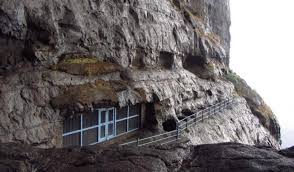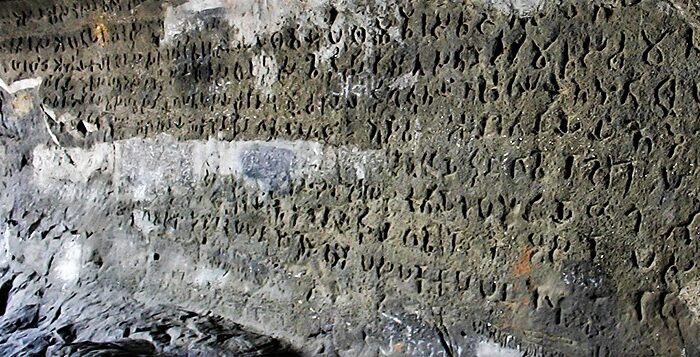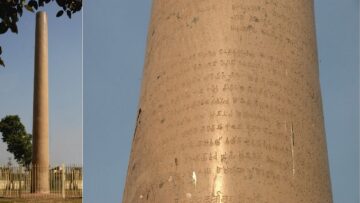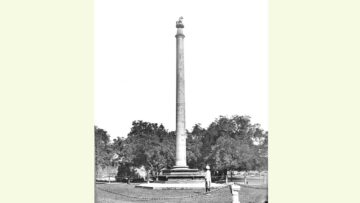Maharashtra has often prided itself for its long and opulent history, albeit a chequered one, and its origins can be traced back to the Stone Age. Its distinct chalcolithic culture is very crucial in understanding and appreciating the history of this great land. The inscriptions of Emperor Aśoka found at Sopara near Mumbai strongly suggests that the Mauryas were the foremost dominant dynasts to rule over Maharashtra. The interregnum between the rule of the Mauryas and the Sātavāhanas witnessed the rule of a few minor houses like those of the Kuras, Bhojas and Mahāraṭhis.
The Sātavāhanas were the first autochthonous dynasts to rule over Maharashtra. There has been an intense debate about the ethnicity of the Sātavāhanas as the Paurāṇic genealogy addresses them as Andhras or Andhra Bhṛtyas whereas the inscriptions of their regime refer to them as the Sātavāhanas. This has led to a few scholars ascribing an Andhra origin to this lineage though their early inscriptions are found in the Nasik-Pune region. However, it is of some note that coins of Simukha, the founder of the Sātavāhana dynasty have been found at a few sites in the present day Andhra Pradesh.
The chronology of the Sātavāhanas has also set off an intense debate amongst the scholars. While a few like V.V. Mirashi have proposed a ‘longer chronology’ which gives the Sātavāhanas a rule of 450 years there are others like Ajay Mitra Shastri that argue for a ‘shorter chronology’ and propose that the Sātavāhanas rule lasted only for about 250 years. For the purpose of this research article, we will adhere to the shorter chronology.
The Sātavāhana rule was well consolidated in Maharashtra by the 1st century BCE. As noted earlier, the Sātavāhana rulers had starting issuing coins right since the commencement of their regime. One of the oldest and historically significant inscriptions of this dynasty is the Nāṇeghat Inscription of the Sātavāhana queen Nāganikā. She was the consort of King Sātakarṇi who was one of the earliest Sātavāhana rulers, evident from an inscription at Sāñcī and the Hāthigumphā Inscription of Khāraveḷa as well as the coins issued by him i.e. Sātakarṇi. The inscription has been written on the left and right sidewalls of a rock-cut cave in Nāṇeghat which is a mountain pass, near the town of Junnar in Maharashtra connecting the western coast to the hinterland. This rock-cut cave has been identified by scholars as the Pratimāghara or a Statue Sanctuary of the Sātavāhanas since originally there were statues of some of the early Sātavāhana kings and princes.

The engravings of this inscription are in the Brāhmī Script and the language is Prākṛt. D.C. Sircar has dated this inscription to the 1st century BCE on the basis of palaeography. The present inscription is extremely valuable in understanding the early history of Maharashtra. Apart from illustrating the details of Queen Nāganikā and King Sātakarṇi, this inscription documents the various Vaidika Yajñas performed by the royal couple and the munificent donations that they made on these occasions. Nāṇeghāṭ is located at a distance of 34 km to the west of the town of Junnar. Nāṇeghat was one of the chief trade routes of those days and was frequented by traders and caravans. This trade route connected Junnar with the prosperous ports of western Maharashtra like Sopara, Kalyan and Chaul on one hand and Pratiṣṭhāna (modern Paiṭhaṇa) on the other. Junnar itself is a site of immense historical value and has clusters of Buddhist cave complexes excavated in the hills in its vicinity. In the 1st century CE, it was the capital of the Kṣaharāta Kṣatrapa ruler Nahāpāna. The reason behind the queen getting this inscription written at such a strategic point must have been the dissemination of the pious deeds initiated by her and her husband towards her subjects (Gokhale, 2007: 112).
Religious Importance:
The Nāṇeghāt Inscription of Queen Nāganikā sheds valuable light on the prevalence of the Vaidika Dharma in the Deccan Region in the 1st century BCE. The inscription opens with the invocation of deities like Dharma, Indra, Saṃkarṣaṇa, Vāsudeva, Candra, Sūrya and the four lokapālas or guardians of the world, namely Yama, Varuṇa, Kubera and Vāsava. Thus along with the Vaidika gods, the Pāñcarātra votaries Saṃkarṣaṇa and Vāsudeva have also been invoked. We get inscriptional, numismatic and material evidence for the worship of Saṃkarṣaṇa and Vāsudeva from the 2nd century BCE. Their worship was in vogue at various sites in South Asia, like Ai Khanoum (now in modern Afghanistan), Mathurā, Ghosundi and Besnagar.
The fact that the two Vṛṣṇi heroes have been invoked right at the beginning of a royal epigraphy is an attestation of their pre-eminence in the religious life of the Deccan Region in the 1st century BCE. A point that is noteworthy is that Indra and Vāsava are mentioned separately. Here Indra is mentioned as a Vaidika deity and Vāsava finds a reference as a lokapāla. Usually Vāsava is taken to be another name for Indra. The other Vaidika gods like Kubera, Yama and Varuṇa had now assumed the roles of lokapālas and thus there was a major transformation in their original nature and functions in the Vaidika pantheon. After these invocations, there is a reference made to Kumāravarasa which has been interpreted by V.V. Mirashi as Kārttikeya who has Kumāra as one of his epithets, but Dr. Shobhana Gokhale comments that this may be “an attribute” of Sātakarṇi (Gokhale, 44: 2019).
The Sātavāhanas, especially Sātakarṇi and his queen Nāganikā were undoubtedly champions of the Vaidika Dharma and they demonstrate a firm belief in the Yajña Sansthā, which is its essence. The names of deities appearing at the beginning of the inscription followed the detailed inventory of the Vaidika Yajñas is a testimony of the fact that the Vaidika Dharma was well established in the Deccan Region in the 1st century BCE. This was also the time when Buddhism was gradually rising as a dominant religion and by the first few centuries of the Common Era, the town of Junnar and its surroundings came under its influence.
We will now discuss in detail the numerous Vaidika Yajñas that were performed by King Sātakarṇi and his queen Nāganikā. The lines mentioning the performance of the Vājapeya yajña signify the first victory achieved by Sātakarṇi. The performance of the Rājasūya yajña highlights the establishment of the kingdom by Sātakarṇi and the performance of two Aśvamedha yajñas implies that Sātakarṇi emerged as the unchallenged sovereign not once but twice. He also issued an Aśvamedha type of a coin to commemorate these yajñas. Dr. Shobhana Gokhale makes a very keen observation that most of the Vaidika yajñas were performed as per the injunctions enlisted in the Baudhāyana Śrautasūtra and in accordance with the śāstras (Gokhale, 2006: 74). Let us now briefly review the list of Vaidika yajñas given in the inscription.
1. Agnyādheya:
This is the first yajña that has been mentioned in the inscription. During this yajña, all the family members of the yajamāna have to bring the sacrificial fire to the altar accompanied by the Adhvaryu. This yajña lasts for a day and the queen made donations of 12 cows and one horse, most probably to the officiating priest.
2. Anvārambhaṇiya:
This yajña too was performed for a day and one cow was donated.
3. Vājapeya:
The name Vājapeya has been completely obscured by the ravages of time, but the details of donations made during this sacrifice have survived. This sacrifice lasted for 17 days and the donations included 1700 cows, 10 elephants, 17 pots and 289 bundles of cloth. The number 17 has a special significance in this yajña. Dr. Shobhana Gokhale comments that this is a unique instance where the three digit number 289 has been numerically represented in an inscription (Gokhale, 2006: 75). This yajña is to be performed when the king accomplishes a grand victory and the performance of this yajña suggests that Sātakarṇi must have been victorious in a major battle.
4. Angārika:
The duration of this yajña is 7 days and the donations made on this occasion consisted of 11,000 cows and 1000 horses.
5. Name mutilated:
When this particular yajña was performed, the donations made were of 24,000 Kārṣapaṇas, most probably to the priests and 6001 Kārṣapaṇas to the visitors.
6. Rājasūya:
The duration of this yajña was two years and the donations made on the occasion of this yajña included a cart with large heaps of grains, 10 good pieces of clothing, one horse, numerous one horse chariots and 101 cows. The Rājasūya yajña was also closely linked to the political career of Sātakarṇi and his ambition for conquests.
7. Aśvamedha:
The Aśvamedha yajña was performed for 3 years. Sātakarṇi performed this yajña twice which implies that he had to establish his sovereignty twice and that there is a possibility that his supremacy may have been challenged after the performance of the first Aśvamedha yajña. The second Aśvamedha yajña, in all probability indicates his regaining his hegemony. Sātakarṇi extended the Sātavāhana rule beyond the Deccan Region and he was undoubtedly a great conqueror. In the inscription he has been eulogised as ̍Pṛṭhvyāḥ Prathama Vīra ̍ or the foremost warrior of the earth. The donations given during these sacrifices included a horse with silver trappings and decorated with gold ornaments, 14,000 Kārṣapaṇas and one cart with grains. Apart from these, a village was also donated and this is one of the first instances of the donation of a village to a beneficiary and this custom was continued by the later Sātavāhana rulers and became a common practice by the Gupta period. The Śatapatha Brāhmaṇa mentions different types of Aśvamedha yajñas. Different varieties of animals – both wild and domesticated were to be brought to the yajña vedi and the wild animals were to let go after the fire was taken around them (Gokhale,2006: 76).
8. Saptadaśātrātra:
This yajña was carried out over 7 days with donations of 1 horse with silver trappings, 10,000 Kārṣapaṇas and 17 cows.
9. Bhagaladaśarātra:
This yajña was to be performed for a month and 10,001 Kārṣapaṇas were donated on this occasion.
10. Gargatrirātra:
Lasting for 3 days, this yajña culminated with distribution of 301 garments to the guests who had assembled for the yajña.
11. Gavāmayana:
Performed for a period one year, this yajna comprised of donations of 1101 cows, 101 Kārṣapaṇas to guests, 100 garments and a chariot.
12. Aṅgirasāmayana:
This yajña too had a duration of 1 year and 1101 cows were donated on this occasion but this yajña has not been recorded in the Baudhāyana Śrautasūtra.
13. Śatātirātra:
1101 cows were given in donation after this yajña but the mention of such a kind of yajña is not found in the Baudhyāyana Śrautasūtra.
14. Aṅgirasatrirātra:
1102 cows were donated on the performance of this yajña which lasted for 7 days. No mention of this yajña is found in the Baudhāyana Śrautasūtra.
15. Chandopavamānātrirātra:
This yajña with a donation of 11,101 cows was conducted for 3 days. There is no mention of this yajña in the Baudhāyana.
16. Trayodaśātirātra:
This yajña lasted for a month and the details of the donation are illegible.
17. Daśarātra:
The duration of this yajña was 1 month and the donation consisted of 1101 cows.
20. Āptoryāma:
This yajña lasted for 7 days and the details of the donation are unavailable.
19. Śaṭātirātra:
The details of this yajña are not known from any of the sources.
20. Aṇgirasāmayana:
This was a yajña which was performed for 6 years and 1100 cows were donated. This does not find a mention in the Baudhāyana Śrautasūtra.
21. Saptadaśatirātra:
The duration of this yajña was 7 days and the donations made included 17 cows, a decorated horse and 10,000 Kārṣapaṇas. This yajña too is not referred to in the Baudhāyana Śrautasūtra.
Dr. Shobhana Gokhale is of the view that the Yajña Bhūmi of the Sātavāhanas must have been at Junnnar, situated on the banks of the River Kukadi. She does not support the claim of those scholars who state that the Yajña Bhūmi of the Sātavāhanas must have been located at Paiṭhaṇa, the capital of the Sātavāhanas. To bolster her view, she cites the fact that the Āpatoryāma sacrifice which has been mentioned in the inscription was to be performed on the banks of a river and the bank of the Kukadi must have been an ideal location for the same. (Gokhale, 2019: 36). She further adds that the water from the River Kukadi must have been used for rituals like Avabhṛtasnāna and Agnyādheya (Gokhale, 2019: 37). Moreover, the bed of the river Kukadi has yielded the coins jointly issued by Sātakarṇi and Nāganikā, and the Aśvamedha type of coins minted by Sātakarṇi (Ibid). On the basis of epigraphs from Junnar which mention the names of donors like Krami Yajñaputa and Krami Yajñlā, Dr. Shobhana Gokhale arrived at the conclusion that these persons must have belonged to a Brāhmaṇa colony established by Sātakarṇi near Nāṇeghāṭ and these Brāhmaṇas must have played an active role in the performance of the sacrifices. Dr. Gokhale also tried to illustrate that the Roman silver coins coming into the Deccan Region because of the Indo-Roman Trade must have been melted by Sātakarṇi to produce his own coinage. We have already seen that a large amount of Kārṣapaṇas were given as donations during the sacrifices. There is a reference to a guild of braziers mentioned in one of the inscriptions from Junnar. Thus from the religious and economic points of view it is plausible to locate the Yajña Bhumi of the Sātavāhanas at Junnar.
The fact that all these yajñas have been enumerated in this inscription speaks volumes about the prevalence and popularity of the Vaidika Dharma even in the 1st century BCE. Though a huge chunk of the population was gradually turning towards Buddhism, a few rulers like Puṣyamitra Suṅga and Sātakarṇi did try to revive and practise the Vaidika Dharma.
Personal Details of Queen Nāganikā and King Sātakarṇi:
Queen Nāganikā is the earliest known queen in the history of Maharashtra. The inscription tells us that she was the wife of King Sātakarṇi and the mother of Princes Skandaśri, Hakusiri and Kumāra Sātavāhana. She was the daughter of a Mahārathi. She had epithets like ̍Nāgavardāyinī ̍, ̍Māsopavāsinī ̍, ̍Gṛhatāpasī ̍ and ̍Caritrabrahmacaryā ̍. The last three of her epithets suggest that she led a very pious life devoted to the performance of numerous vows and austerities. She led a virtuous life, practicing asceticism and detachment.
She effectively managed the administration of the Sātavāhana kingdom after the death of her husband. The Sātavāhana queen might have even had a say in the state matters during the lifetime of her husband and continued to command a position of power and respect even after his demise. This is evident from the coins jointly issued by Sātakarṇi and Nāganikā which bear their names in the Brāhmī script. The inscription testifies the fact that Sātakarṇī must have extended the frontiers of his kingdom throughout the Deccan Region as well as parts of Central and Southern India as he is called ̍Dakṣiṇāpathapati ̍ or the Lord of Dakṣiṇāpatha. Sātakarṇi has also been described as ̍Apartihata cakra ̍ which in the opinion of Dr. Shobhana Gokhale is indicative of his sovereignty (Gokhale, 2006: 78). The royal couple was an ardent follower of the Vaidika Dharma. In the opinion of Dr. Shobhana Gokhale, Vediśri was an epithet of Sātakarṇi and not any other Sātavāhana prince (Gokhale, 2019: 45). He rightly deserved this epithet as he had performed a number of Vaidika yajñas.
The inscription emphatically states that King Sātakarṇi also performed numerous philanthropic acts. He was a ruler who gave boons to those who sought his refuge and made generous gifts of wealth to them. King Sātakarṇi was in possession of the three royal powers, namely Mantra Śakti (power of proper counsel), Prabhu Śakti (the premier position of the ruler) and Utsava Śakti (the power of energy) (Gokhale, 2019: 55).
Economic Importance:
The cave in which the present inscription has been engraved is located on the strategic Nāṇeghāṭ, which was a major trade route of the Sātavāhana times and even later. The magnanimous donations given by the royal couple are clear indications of the prosperity the Sātavāhana state enjoyed. There was no paucity of coins as thousands of Kārṣapaṇas were given in donation during the yajñas. The references to coins in the inscription have been proved by the available numismatic evidence. Two kinds of coins have been mentioned in the inscription and they are ̍Kārṣapaṇās and Prasparka. These are one of the earliest epigraphical references to the coins. The money economy of the Sātavāhanas even at this early stage of their rule was very strong. The river Kukadi has her source at a distance of about 5 km before the start of Nāṇeghāṭ. There is also a medieval temple of Śiva known as Kukaḍeśvara near this spot.
There is also a small settlement called Kakuḍner there. The word ̍Kakud ̍ means a bull and Dr. Shobhana Gokhale has conjectured that there might have been a high possibility that the Sātavāhanas had their own royal cow pen at the foot of Nāṇeghāṭ and it is from here that cows must have been procured to give as donations. This is reaffirmed by the large number of cows which were offered as donation. The multitude of donated cows underlines the significance of ‘Go Dāna’ in the Vaidika Dharma and the religious merits that it leads to. Horses and elephants too were a part of donations. The system of giving agricultural fields and villages was steadily coming into vogue and the present inscription records the donation of a village during the Aśvamedha yajña. References to silver and gold ornaments as well as carts full of grains are clear markers of the affluence of the Sātavāhanas. It also sheds light on the high level of craft production and specialization.
The Nāṇeghāṭ inscription of Queen Nāganikā is thus a very crucial historical evidence that helps us in understanding the early history of Maharashtra shedding light on its religious, economic, social and political aspects.
References:
- Gokhale, Shobhana. Junnar Inscriptions. Pune: Bhandarkar Oriental Research Institute, 2019.
- Gokhale, Shobhana, Purabhilekhavidya, Pune: Continental Prakashan, 2007 (2nd Edition).
- Gokhale, Shobhana. “Significance of the Vedic Rituals Mentioned In The Naneghat Inscription”. In Understanding the Vedas. Edited by Bhagyalata Pataskar, 72-84. Pune: Vaidika Samshodhana Mandala, 2006.
- Mirashi V. V, The History and Inscriptions of the Satavahanas and Western Kshatrapas, Bombay: Maharashtra State Board for Literature and Culture, 1981.
Disclaimer: The opinions expressed in this article belong to the author. Indic Today is neither responsible nor liable for the accuracy, completeness, suitability, or validity of any information in the article.










